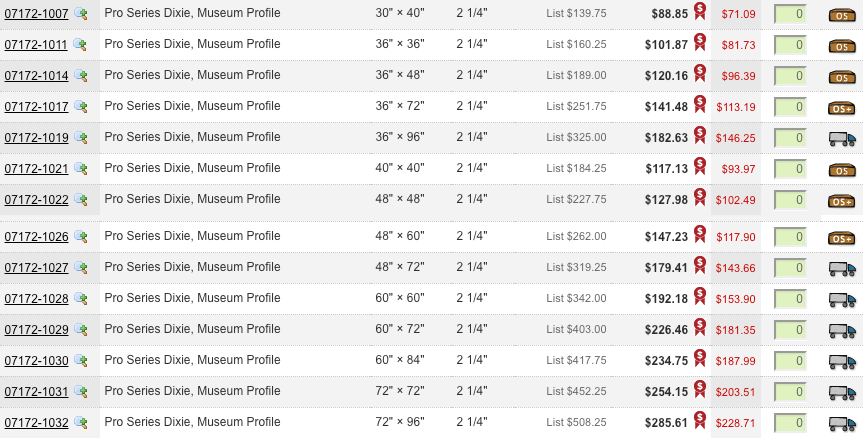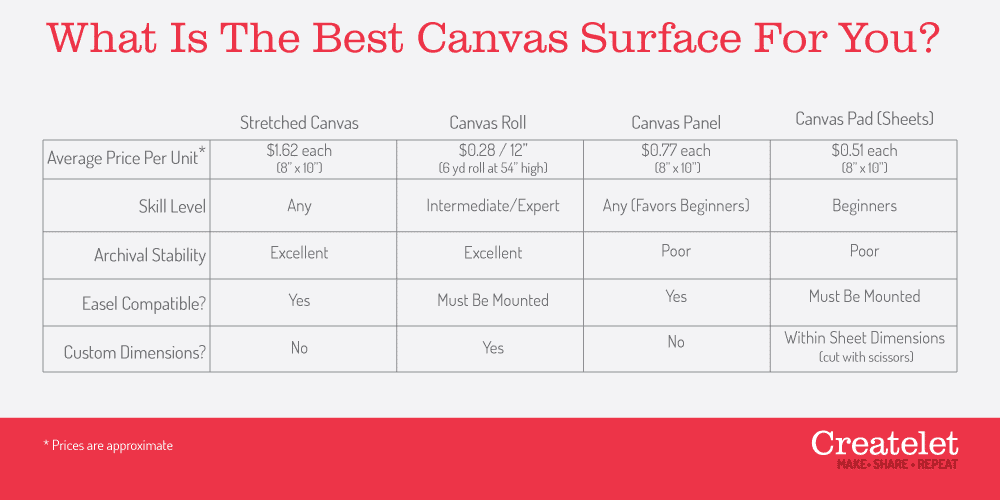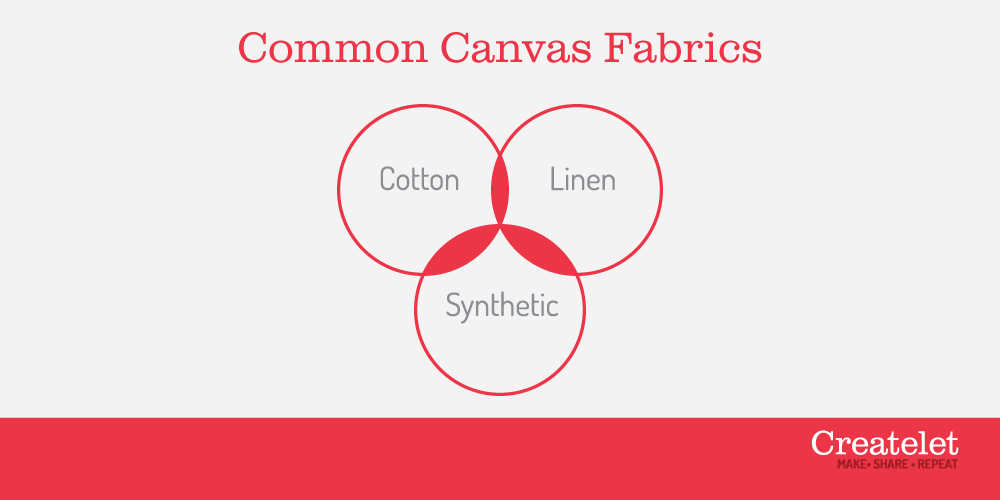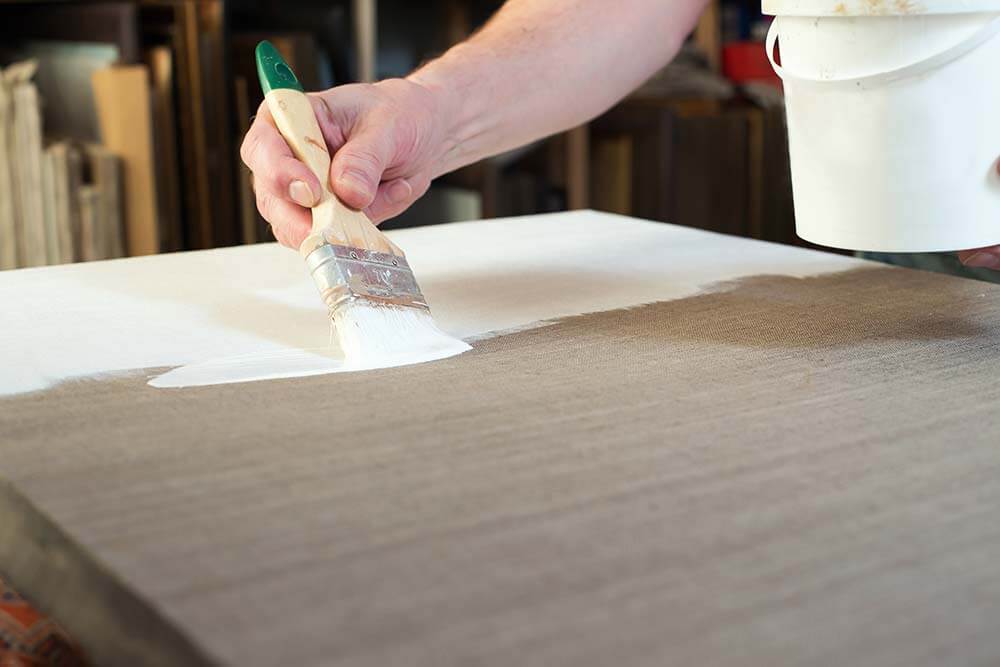Today we wanted to take a deep dive into the types of canvases available for painting.
While we recently covered some important pointers when it comes to painting on canvas, today we want to strictly talk about canvas selection (and what to look out for).
As any budding artist will tell you, when you go to your local art store or browse the canvas surface section of your favorite online retailer, it can be a bit intimidating to say the least.
Not only are you met with different sized canvas surfaces, but you will also have to decide between stretched canvas, panels, ‘professional’ canvas, canvas rolls, unprimed vs. primed, and more.
Seriously, a quick look at the DickBlick.com website will leave you with more questions than answers:

Note: We love DickBlick.com and their wide selection, however, sometimes an artist just starting out needs a fair bit of help navigating this wide product selection!
So, in order to try to make the process of learning about the different types of canvases available for painting, we wanted to break out this article into digestible chunks:
Let’s start with (what we think) is the most obvious decision when it comes to canvas selection:

Table of Contents
Canvas Form Factors (Stretched, Panels, Pads, and Rolls) – What Should You Really Be Using?
To cut right to the point, when deciding on the form factor that you use for canvas, we would recommend going with canvas panels for practice and stretched canvas for pieces that are to be hung or sold.
Here’s why:
Whether you are using oil or acrylics, when painting on a panel, the surface will be susceptible to warping over the years.
Secondly, panels appear to be cheap when compared to their stretched counterpart.
Now this may not be the case as some canvas panels can cost quite a bit more than their stretched counterpart (i.e. Blick Premier Heavyweight Cotton Archival Panels), their perception can really lower the market perception of your work – and ultimately the price they are willing to pay.
Therefore, for all artists who put their work up for sale, we would recommend going with stretched canvas in order to boost your bottom line.
When it comes performance between panel and stretched canvases, the biggest difference between these two will be the play or give that stretched canvas allows.
This largely boils down to personal preference on what you may prefer when painting.
The last note that we want to touch on is the price of these two types of canvas surfaces:
While we mentioned briefly that some canvas panels can cost more than a stretched canvas, on the whole, panels do tend to cost less.
For beginning artists, we would recommend buying a canvas panel classroom pack as it will yield you around 24 to 30 panels that typically cost less than $1 each.
Doing so will allow you to fully explore your mediums without feeling like you are wasting money.
But canvas form factors doesn’t end at panels and stretched canvas…
…deeper within the art supply store, you are also going to find canvas rolls and pads (sheets).
Let’s first take a look at canvas rolls:
Canvas rolls are typically reserved for artists who like to make their very own stretched canvas to the exact dimensions they want for their piece.
But why would an artist do this?
For a few reasons:
First, you can make a piece precisely to your preference.
Second, large stretched canvases can be incredibly expensive!
For instance, this sampling of large canvases can cost up to $285.61 for a single stretched canvas:

Note: Prices from the Fredrix Pro Series Dixie Cotton Canvas
Doing this yourself can save quite a bit if you plan on making artwork of this scale regularly.
Lastly, some artists really love the hands-on approach.
Making a piece from raw materials to a final painting is incredibly rewarding!
It really plays into the DIY mentality that many of us artists share (and what makes this community so great)!
Let’s switch gears for a minute…
Now on the other end of the spectrum you have canvas pads.
If you thought canvas panels were cheap at under $1 a piece, canvas sheets are even more affordable costing typically around .50 cents for each sheet.
This further lowers the financial barrier when exploring the world of painting and testing new techniques.
Now sheets aren’t great for archival nor can they stand upright on an easel.
Therefore, they will need to be taped to a rigid surface or placed on a table when being painted on.
Given all these drawbacks, its best to use these as ‘toss away’ pieces.
Determining The Best Type Of Canvas For You
Many artists don’t necessary stick to one or two form factors for very long.
Instead, they may find themselves floating between them throughout their career.
Therefore, we wanted to put together a very loose chart of the different form factors for canvas surfaces in helping you make the selection that is best for you:

Here Are The Different Types of Canvas Fabrics For Painting On
Now if covering all the different types of canvas form factors isn’t dizzying enough, we now need to take it a step further – canvas fabrics.
When looking at the options available, you will largely find three different types:
- Cotton
- Linen
- Synthetic
As you can see in the diagram below, there may be a very small overlap when it comes to fabrics:

While you nearly always see simply a cotton or linen fabric, don’t be surprised if you come across some that are a blend between cotton/linen, as evident here:

Note: Prices from the Caravaggio Acrylic-Primed Cotton/Linen Canvas Rolls
Or even perhaps between cotton/polyester:

Note: Prices from the Caravaggio Cotton/Polyester Canvas Rolls
Now it’s worth noting, likely due to manufacturing constraints coupled with market demands, you will often find blend fabrics only in canvas rolls.
Performance and Price Of Different Canvas Fabrics
One of the most important aspects for artists when deciding between these three popular variants of canvas fabrics will undoubtedly be the performance when compared to price.
Here’s a bit on what you can expect when deciding on the three common fabric:
Cotton Fabric Is Perfect For Artists On A Budget
Cotton will by and far be the most affordable fabric of the three.
As a beloved fabric by artists for centuries, cotton has withstood the test of time when it comes to its archival properties.
But beyond archival intent, the main reason cotton is so pervasive as a fabric is the price.
Anyone who is in art school or are simply dipping their toes into painting as a hobby for the very first time will often find themselves gravitating to cotton for this very reason.
With its ability to perform well on smaller scale or pre-defined sizes, cotton is great for beginners and even intermediate level artists.
Also to note, cotton is extremely absorbent, making it perfect for holding your medium.
In fact, according to the University of California, cotton can retain 24-27 times its own weight in water!
Secondly, if you are more of an advanced artist who stretches their own canvas, you will find the flexibility in cotton will be great…
…but naturally there is going to be a catch:
While the flexibility and ability to support your acrylic or oil paint can be substantial, too large of a cotton surface can be a drawback…
Here’s why:
With large scale pieces, cotton fibers tend to be a bit too flexible for some artists and may develop a fair bit of slack.
So, what’s the fix?
Meet linen:
Linen, Often The Fabric Choice For Expert Artists With Ample Budget
As we just were saying that cotton fabric is incredibly cheap, the opposite holds true when it comes to linen.
To put it simply, linen is expensive.
Therefore, many beginning artists find themselves avoiding this fabric…
…and that’s completely ok!
When you are still trying to learn the optimal painting techniques, there is absolutely no reason why you should blow your budget on a fabric that you don’t fully reap all the great benefits.
But as you progress through your art career and get featured in a few local galleries, you may want to take a look at this alternative fabric.
Why?
Like cotton, linen can come in many different weights and textures that can provide a finish that can be anywhere between rough or smooth.
Secondly, linen also appears to be more natural (and I say that loosely as cotton of course is natural) as you will see some imperfections or slight variations in the colors from the flax plant when it was sourced.
While linen can be difficult to properly affix to stretcher bars given its very little flexibility (especially when compared to canvas), once attached it shouldn’t experience much slack with time.
Linen, like cotton, has incredible long term archival properties – key for collectors.
Lastly, and perhaps most importantly, is artist marketability.
While many gallery owners or buyers may not openly admit this, linen is simply a more marketable fabric when compared to cotton.
The longer staples of linen (typically between 1” to 6”) when compared to cotton (1/8” to 2.5”) will present much better, and likely add more money to both yours, and the gallery’s bottom line.
Therefore, if you take your painting a bit more seriously and plan on making the rounds in displaying your work, then we would recommend to make the switch to linen in order to make your pieces stand out from the rest.
You can check out Dick Blick’s wide selection of linen fabrics by clicking here.
Are Synthetic Fabrics Worth Considering?
We are big believers that you should try painting on a new surface at least a few times before you fully evaluate.
Whether it’s a big hunk of metal or even simply a non-traditional canvas alternative, the experiences you learn as an artist are nearly always worth it.
While it’s not nearly as large as a leap when compared to painting on metal, we would still recommend artists to give a synthetic fiber a try.
In the grand timeline of painting surfaces, polyester is just a blip (invented in 1941 during WWII).
Therefore, it hasn’t withstood archival tests like famous pieces that have been made centuries ago.
While many manufacturers and artists do feel optimistic about its longevity, it’s simply untested in this regard.
But here’s the deal:
Unlike linen or cotton that may exhibit natural qualities in the weave of the fabric itself, polyester for the most part is going to be nearly uniform.
For the artists looking to make their own stretched canvas, polyester will give you the most predictable results – which can be a good thing.
The flexibility in this fabric will often be far greater than canvas, making it much easier to assemble your custom large scale surfaces. Furthermore, given the synthetic properties of this fabric, you won’t likely experience the same slack you would otherwise see in cotton.
Oh, and about the price:
Synthetic can vary wildly…
So be sure to price accordingly and compare between your local art supply store and online.

Should You Go With A Fine Or Rough Texture For Your Canvas?
As we learned that canvases can come in many different forms and fabrics, surely that’s all there is to know…
…right?!
Of course not!
But don’t worry, texture is a bit easier to digest!
The general rule (not a hardline rule) is that you should use a finer texture fabric on small pieces and rougher fabric on larger pieces…
…but why?
When painting a small scale piece (think less than 10” in diameter), you are likely going to be using many of your finer paintbrushes.
The finer texture of the fabric will be much more receptive to these brushes (and ultimately better control).
On the flip side, for a rough texture that is at a much larger scale your detail work is likely going to be non-existent.
Likewise, a large-scale painting will often be displayed further away from the viewer making the reliance on a finer fabric simply not necessary.
But, it goes without saying, the piece that you plan on putting together and the message you want to convey will largely dictate the texture of the fabric most of all.
However, we just wanted to give some general pointers so you don’t break the budget paying for a finely woven linen that may cost three times as much as a medium or rougher texture fabric.

Primed Or Raw Canvas – Which Is Better?
Cost aside, you will find that canvases can come in either primed or raw (natural).
Is there a reason why you should select one over the other?
In all honesty, it depends.
Primed canvases are nice as they offer the convenience of having the manufacture prep your surface for you. This allows you to get started with your initial wash of your painting immediately.
With raw canvases, you will need to make sure that you apply a primer (gesso), prior to painting.
Skipping this essential priming step will not only often produce lackluster results, but will also absorb an excessive amount of your medium which can be costly (remember we said that cotton can carry 24-27 times its weight in water).
Application of gesso is extremely simple and can be done relatively quick, especially if you plan on prepping several canvases at the same time.
Furthermore, even if you do decide to invest in primed canvases, an additional layer of gesso can’t hurt as it will often help to provide a more receptive texture for your medium, ultimately making for better performance.
From Form To Fabric And Everything In-Between Canvases Are Complicated
As we started this article simply talking about the wide selection of canvases you can find online or at the art supply store can be daunting to say the least, we hope that this guide can serve as a jumping point for navigating the somewhat overly complicated canvas aisle.
The most important way to develop yourself as an artist however, will be by simply experimenting along the way!